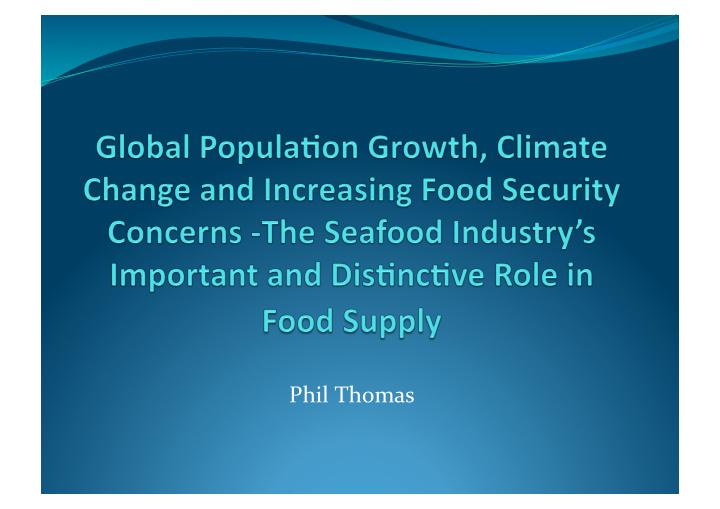



Phil ¡Thomas ¡ ¡
Across ¡the ¡world, ¡we ¡are ¡facing ¡a ¡gathering ¡storm ¡ arising ¡from ¡popula6on ¡growth, ¡climate ¡change ¡ and ¡issues ¡of ¡food ¡security! ¡
Key ¡factors ¡ Population ¡ Limited ¡ increase ¡ Increased ¡ land, ¡ ¡ sustainable ¡ water ¡ ¡and ¡ food ¡ ¡ other ¡ production ¡ Food ¡ resources ¡ securi ty ¡ Increased ¡ Climate ¡ ¡ affluence ¡ ¡ change ¡ and ¡social ¡ impacts ¡ ¡ Diet ¡and ¡ changes ¡ food ¡ ¡ culture ¡ changes ¡ ‘Food security exists when all people, at all times, have physical and economic access to sufficient, safe and nutritious food to meet their dietary needs and food preferences for an active and healthy life’. FAO (2003)
Global ¡popula1on ¡increase ¡ ¡ Region Population increase 2050 v 1995 (M) Asia 1985 Sub-Saharan 1193 Africa Latin America & 328 Caribbean China 295 North Africa 125 North America 91 Oceania 17 Europe -89 Depending on assumptions about diet composition and food waste, global food production must increase to 150% by 2050.
Food ¡Security: ¡hunger ¡and ¡price ¡vola1lity ¡ FAO Food Price Index (FPI) World Hunger FOPI Undernourished FPI % Undernourished 2007 2009 2010 Indexed 2002-2004
Price and price volatility affect food security and have social impacts in developed as well as developing countries.
Food ¡culture ¡ Developing Countries As affluence increases so does calorie intake. People eat more meat, dairy produce, eggs and fish. Industrialised Countries Calorie intake high, and obesity and Type 2 diabetes are issues. But, diet and health trends increase fish and seafood intake – nutritious protein, high omega-3 and convenient. But ---! There are huge differences in food cultures between countries. ¡
Climate ¡change ¡ Atmospheric CO 2 and surface temperature changes 1800-2005 Climate change will involve more extreme weather patterns more/less rain and seasonal shifts affecting crop and animal agriculture on land – but effects will vary from region to region.
Sources ¡of ¡greenhouse ¡gases ¡(GHG) ¡ Rapid industrialization has boosted GHG production in China. CO 2 (Gt/yr) USA China India UK Agriculture’s GHGs include CO 2, N 2 O from fertilizers and methane from cattle and sheep.
Climate ¡change: ¡marine ¡and ¡freshwater ¡ ¡ Oceans ¡and ¡freshwater ¡bodies ¡ ¡are ¡warming ¡– ¡at ¡surface ¡ and ¡some ¡deep ¡warming. ¡ pH, ¡salinity, ¡sea ¡level ¡all ¡increasing. ¡ Changes ¡in ¡ocean ¡circulation ¡and ¡coastal ¡upwelling; ¡ice ¡ cover ¡is ¡reducing. ¡ ¡Ocean ¡ ¡effects ¡on ¡food ¡webs, ¡marine ¡species ¡breeding, ¡ migration, ¡ ¡production, ¡ ¡abundance ¡ ¡and ¡distribution. ¡ Freshwater ¡effects ¡from ¡warmer ¡water, ¡river ¡spates ¡and ¡ flooding ¡but ¡also ¡from ¡drought ¡and ¡water ¡shortages. ¡ ¡ Climate change will involve effects on finfish and shellfish fisheries and on aquaculture – but effects will vary from region to region.
Climate ¡Change: ¡food ¡produc1on ¡on ¡land ¡
Climate ¡change: ¡vulnerability ¡of ¡fish-‑ dependent ¡na1ons ¡ Darker colour = more vulnerable After: Allison et al (2009)
Global ¡Food ¡Fish ¡Supply ¡ ¡ Global Food Fish Supply by Global Food Fish Supply by Continent Species Group Species Group % Total Freshwater & 32 diadromous Demersal 18 % Pelagic 18 Other marine 7 Crustaceans 10 Molluscs 11 Cephalopods 3 From: FAO (2009)
Increase ¡Global ¡Aquaculture ¡Produc1on ¡ Region 1970 2008 2008 (Mt/yr) (Mt/yr) (% total) World 2.57 52.6 Asia 1.8 46.7 88.8 (China) (0.8) (32.7) (62) Europe 0.5 2.4 4.5 Africa < 0.1 0.9 1.8 North America > 0.2 0.6 1.2 Latin America < 0.01 1.8 3.4 Oceania < 0.01 0.2 0.3 After: FAO (2010) Rounded figures
Fish ¡price ¡infla1on! ¡ UK Sunday Times 3 April, 2011 ‘ Seafood prices have risen by 11.5% in the last year - a greater increase than any other type of food - according to the Consumer Price Index, the benchmark measure of inflation.’ ‘The cost of farmed salmon has doubled in 18 months.’
Food ¡policy ¡implica1ons ¡for ¡European ¡ Governments? ¡ Food policies should: Plan for future needs for increased sustainable food production – providing food security for all. Ensure stability in food supply – reduce volatility in supply and price. Strive for global access to food to end hunger. Manage and mitigate the impact of climate change. Protect biodiversity and ecosystem resources.
Food ¡policy ¡implica1ons ¡for ¡European ¡ Governments? ¡ Food from fish policies should: Recognise that diet and health policies advocate fish as a key part in a healthy diet (but EU is only 40% self-sufficient in fish). Fully support fish production from sustainable fisheries and manage fisheries to optimise yields. Expand sustainable aquaculture production in line with growing global needs for fish.
The End
Recommend
More recommend